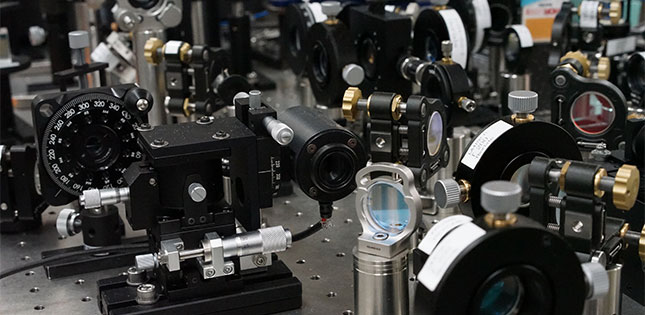Researchers at Tohoku University in Japan have developed a simple and robust way to generate photons entangled in two different frequencies -- colors of light. The demonstrated technique is expected to play an important role in high-capacity optical quantum information and communication applications using the frequency degree of freedom.
Frequency, or color, is the most familiar property of light for humans and is used for many scientific and industrial applications such as sensing, imaging, medicine, and telecommunication.
However, in quantum information science, generation and manipulation of photons having desired frequency characteristics are challenges. In particular, generating photons in a form of frequency "entanglement" -- a key resource in quantum information processing -- is very important, but previous schemes need complicated interferometers and/or frequency (color) filtering that are likely to be accompanied by a high degree of loss. Since lost single photons cannot be restored (unlike classical states of light such as laser light), such loss can introduce critical errors in many quantum information applications.
"Our method is very simple and robust, and therefore useful for handling fragile entangled photons," said Dr. Fumihiro Kaneda of the Frontier Research Institute of Interdisciplinary Sciences at Tohoku University.
The team comprised of Dr. Fumihiro Kaneda and Professor Keiichi Edamatsu at Tohoku University, and Professor Ryosuke Shimizu at the University of Electro-Communications has devised a nonlinear optical crystal which can directly produce pairs of photons with frequency entanglement when excited by laser pulses. In the crystal, spontaneous polarization is poled with two different periods that enable the crystal to produce photon pairs in two different and symmetric ways.For example, when a horizontally polarized photon is red (yellow), the other twin with vertical polarization is yellow (red). Thus, the photons' frequencies can be quantum-mechanically correlated, i.e., entangled.

An illustration of our scheme for producing color entangled photons. A nonlinear crystal has two different poling periods so that produced photon pairs with orthogonally polarized photon pairs can be frequency entangled. ©Fumihiro Kaneda
The team has verified the frequency entanglement in the generated photons by measuring two-photon interference: the observed beating oscillations with the difference frequencies (~11.5 THz) of photons is a clear signature of the frequency entanglement.
The demonstrated technique can be extended to generation of entanglement in more than two frequencies by simply adding more numbers of poling periods. Such high-dimensional entanglement will be an important resource for advanced quantum information applications such as high-dimensional quantum communication.
Publication Details:
Title: Direct generation of frequency-bin entangled photons via two-period quasi-phase-matched parametric downconversion
Authors: Fumirhiro Kaneda, Hirofumi Suzuki, Ryosuke Shimizu, and Keiichi Edamatsu
Journal: Optics Express
DOI: 10.1364/OE.27.001416
Contact:
Fumihiro Kaneda
Frontier Research Institute of Interdiciplinary Science
Email: kaneda riec.tohoku.ac.jp
riec.tohoku.ac.jp
Websites:
http://www.quantum.riec.tohoku.ac.jp/
http://rs.pc.uec.ac.jp/index-e.html


